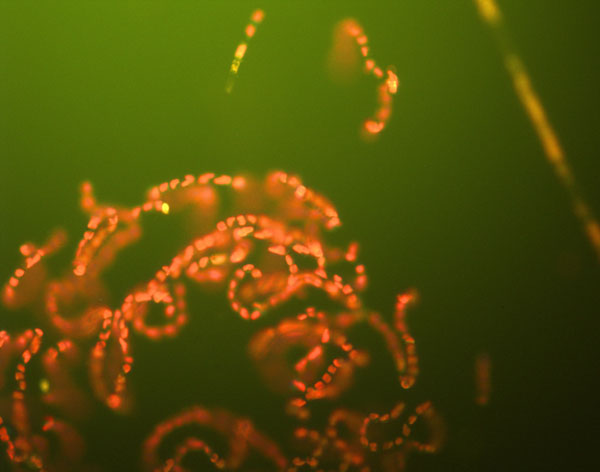Red Glow Sheds Light on Ocean Health

The red fluorescent glow of certain ocean plants has been detected by a NASA satellite. Measurements of this unique signal can reveal the health of the global ocean and how human activities are affecting it.
The red glow comes from marine phytoplankton, which are microscopic, single-celled plants that turn sunlight and nutrients into food through photosynthesis.
These tiny plants fuel nearly all ocean ecosystems, serving as the most basic food source for marine animals from zooplankton to fish to shellfish. In fact, phytoplankton account for half of all photosynthetic activity on Earth.<
The health of these marine plants affects commercial fisheries, the amount of carbon dioxide the ocean can absorb, and how the ocean responds to climate change.
Over the past two decades, measurements of the green pigment chlorophyll have provided an indicator of the quantity of plant life in the ocean. But with the Moderate Resolution Imaging Spectroradiometer (MODIS) on NASA's Aqua satellite, scientists have now observed "red-light fluorescence" over the open ocean.
"Chlorophyll gives us a picture of how much phytoplankton is present," said team member Scott Doney, a marine chemist from the Woods Hole Oceanographic Institution. "Fluorescence provides insight into how well they are functioning in the ecosystem."
All plants absorb energy from the sun, typically more than they can consume through photosynthesis. The extra energy is mostly released as heat, but a small fraction is re-emitted as fluorescent light in red wavelengths.
Sign up for the Live Science daily newsletter now
Get the world’s most fascinating discoveries delivered straight to your inbox.
Red-light fluorescence reveals insights about the physiology of marine plants and the efficiency of photosynthesis, as different parts of plants' energy-harnessing machinery are activated based on the amount of light and nutrients available. For instance, the amount of fluorescence increases when phytoplankton are under stress from a lack of iron, a critical nutrient in seawater.
So, the MODIS fluorescence data give scientists a tool that enables research to reveal where waters are iron-enriched or iron-limited, and to observe how changes in iron influence plankton.
The iron needed for plant growth reaches the sea surface on winds blowing dust from deserts and other arid areas, and from upwelling currents near river plumes and islands.
The MODIS observations showed, for example, that portions of the Indian Ocean surprisingly "lit up" seasonally with changes in monsoon winds. In the summer, fall, and winter — particularly summer — significant southwesterly winds stir up ocean currents and bring more nutrients up from the depths for the phytoplankton. At the same time, the amount of iron-rich dust delivered by winds is reduced.
"On time-scales of weeks to months, we can use this data to track plankton responses to iron inputs from dust storms and the transport of iron-rich water from islands and continents," Doney said. "Over years to decades, we can also detect long-term trends in climate change and other human perturbations to the ocean."
Climate change could mean stronger winds pick up more dust and blow it to sea, or less intense winds leaving waters dust-free. Some regions will become drier and others wetter, changing the regions where dusty soils accumulate and get swept up into the air. Phytoplankton will reflect and react to these global changes.
More observations of the study, funded by NASA, are detailed in the May 8 issue of the journal Biogeosciences.
- Video – Earth's Changing Oceans
- Earth Checkup: 10 Health Status Signs
- Ocean News, Images and Information










